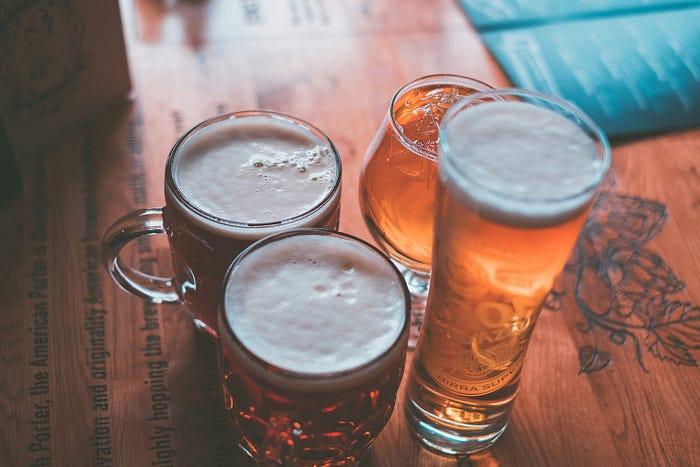Utilizing Brewer’s Yeast: A New Approach to E-Waste Recycling
Written on
The Historical Significance of Beer
For over 10,000 years, beer has been a cherished beverage for humanity. Today, it remains popular across the globe, particularly in regions like the Pacific Northwest, where craft breweries abound. In Portland, Oregon alone, there are at least 70 breweries, allowing enthusiasts to explore a new one every month for five years without repetition.
Brewing beer is a meticulous process that can take anywhere from two to eight weeks. While the end product is delightful, it generates a significant amount of yeast waste. Recent scientific findings suggest that this leftover yeast could play a crucial role in improving the recycling process of electronic waste (e-waste), a pressing environmental concern.
The E-Waste Challenge
Each year, millions of electronic devices—such as smartphones, computers, and televisions—are discarded as they become outdated. Dubbed "e-waste," this category of waste is rapidly escalating, with the World Health Organization labeling it as the "fastest growing solid waste stream in the world."
Improper disposal of e-waste poses serious threats to both human health and the environment. According to the UN's fourth Global E-waste Monitor (GEM) published in March 2024, e-waste is increasing at a pace five times greater than the rate at which it is recycled. From 2010 to 2022, the volume of e-waste surged by 82%, with projections of a further 32% rise by 2030. Alarmingly, only 22.3% of the e-waste produced in 2022 was documented as being collected and recycled properly, leading to an estimated $62 billion worth of recoverable resources being neglected.
The root of these issues lies in the complexities of recycling e-waste, particularly in separating the various metals it contains. Although experts have developed several methods for metal separation, most are inefficient or present environmental hazards.
Innovative Solutions with Biosorbents
One promising avenue is the use of biosorbents—biological materials capable of absorbing pollutants like heavy metals. Yet, traditional methods often generate toxic byproducts, and processes like pyrometallurgy can release harmful emissions.
However, Anna Sieber, a doctoral student at the University of Natural Resources and Life Sciences (BOKU) in Vienna, Austria, alongside Professor Georg M. Guebitz and their team, believe they have found a more effective biosorbent solution using brewer's yeast.
Brewer's yeast, specifically Saccharomyces cerevisiae, is a single-celled fungus that also plays a role in bread making. Although often discarded, this yeast is widely available and inexpensive, making it an appealing option for metal absorption. Sieber notes that, compared to chemical precipitation, biosorption with spent brewer's yeast provides a cost-effective and eco-friendly solution for heavy metal recovery.
The Research Process
To investigate this concept, researchers sourced 20 liters of inactive brewer's yeast, which they then froze, dried, and ground. They mixed this yeast into solutions containing economically significant metals like aluminum, nickel, zinc, and copper. By adding another solution derived from scrapped circuit boards, the team observed how electrostatic interactions between the yeast surface and metal ions facilitated metal absorption.
By adjusting variables such as temperature and acidity, they manipulated the yeast's surface properties to optimize metal attraction. They also tested the yeast against a pre-existing polymetallic waste stream. After each experiment, the yeast was treated with an acid bath to extract the absorbed metals.
The Findings
The results were promising: the researchers successfully recovered over 50% of aluminum, more than 40% of copper, and over 70% of zinc from the circuit board solutions. Additionally, they achieved over 50% recovery of aluminum and over 90% for zinc from the polymetallic waste stream. Notably, zinc absorption increased by 7.6% with temperature adjustments, while aluminum recovery improved by 16% with changes in pH.
Sieber emphasized the economic viability of using yeast biomass, stating that it is a safe organism with demonstrated reusability.
A Sustainable Bonus
Interestingly, the study also uncovered that the brewer's yeast can be reused multiple times—up to five—without losing its effectiveness. Sieber remarked, "The metals can be removed from the yeast surface by acid treatment and thus could be recycled." This opens up avenues for reclaiming valuable metals.
While the potential is exciting, the researchers acknowledge that further investigation is necessary before implementing this technique on an industrial level. Postdoctoral researcher Klemens Kremser highlighted the importance of considering the concentration of interfering metal ions in mixed metal solutions.
The Future of Recycling
The implications of this research are significant. Sieber pointed out that in Austria, where beer production is high, the surplus brewer's yeast could help mitigate both yeast waste and e-waste challenges. While traditional e-waste recyclers often focus on precious metals like gold and silver, the metals tested in this study are still integral to modern electronics.
Biologist Kerry Bloom from the University of North Carolina noted that the abundance and low cost of yeast make this method feasible on a larger scale, provided e-waste recycling facilities are willing to adopt new systems.
Innovative Developments
Following the initial findings, researchers from MIT and Georgia Tech have also applied the concept of utilizing brewer's yeast. They designed a water filtration system that encapsulates yeast in hydrogel capsules. This method allows water to flow through while the yeast captures contaminants like lead, resulting in clean drinking water. The yeast can be easily cleaned and reused, presenting an environmentally friendly filtering solution.
In summary, the exploration of brewer's yeast as a resource for e-waste recycling and water filtration represents a promising step toward sustainable practices. It addresses multiple environmental issues simultaneously while supporting the continued enjoyment of brewing beer.
